Notch signaling controls liver development by regulating biliary differentiation
- PMID: 19369401
- PMCID: PMC2673761
- DOI: 10.1242/dev.029140
Notch signaling controls liver development by regulating biliary differentiation
Abstract
In the mammalian liver, bile is transported to the intestine through an intricate network of bile ducts. Notch signaling is required for normal duct formation, but its mode of action has been unclear. Here, we show in mice that bile ducts arise through a novel mechanism of tubulogenesis involving sequential radial differentiation. Notch signaling is activated in a subset of liver progenitor cells fated to become ductal cells, and pathway activation is necessary for biliary fate. Notch signals are also required for bile duct morphogenesis, and activation of Notch signaling in the hepatic lobule promotes ectopic biliary differentiation and tubule formation in a dose-dependent manner. Remarkably, activation of Notch signaling in postnatal hepatocytes causes them to adopt a biliary fate through a process of reprogramming that recapitulates normal bile duct development. These results reconcile previous conflicting reports about the role of Notch during liver development and suggest that Notch acts by coordinating biliary differentiation and morphogenesis.
Figures
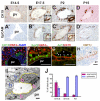
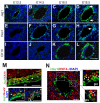


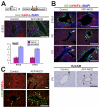
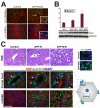

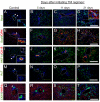
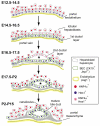
Similar articles
-
[Tissue morphogenesis of liver epithelial cells].Seikagaku. 2012 Aug;84(8):658-65. Seikagaku. 2012. PMID: 23012876 Review. Japanese. No abstract available.
-
Biliary differentiation and bile duct morphogenesis in development and disease.Int J Biochem Cell Biol. 2011 Feb;43(2):245-56. doi: 10.1016/j.biocel.2009.07.020. Epub 2009 Sep 6. Int J Biochem Cell Biol. 2011. PMID: 19735739 Review.
-
[Notch signaling pathway participates in the differentiation of hepatic progenitor cells into bile duct epithelial cells and progression of hepatic fibrosis in cholestatic liver fibrosis rat].Zhonghua Bing Li Xue Za Zhi. 2017 Jun 8;46(6):400-405. doi: 10.3760/cma.j.issn.0529-5807.2017.06.007. Zhonghua Bing Li Xue Za Zhi. 2017. PMID: 28591987 Chinese.
-
Transcriptional profiling implicates TGFbeta/BMP and Notch signaling pathways in ductular differentiation of fetal murine hepatoblasts.Mech Dev. 2006 Feb;123(2):177-94. doi: 10.1016/j.mod.2005.10.003. Epub 2006 Jan 18. Mech Dev. 2006. PMID: 16412614
-
Notch signaling regulates bile duct morphogenesis in mice.PLoS One. 2008 Mar 26;3(3):e1851. doi: 10.1371/journal.pone.0001851. PLoS One. 2008. PMID: 18365007 Free PMC article.
Cited by
-
Liver Organoids: Recent Developments, Limitations and Potential.Front Med (Lausanne). 2021 May 5;8:574047. doi: 10.3389/fmed.2021.574047. eCollection 2021. Front Med (Lausanne). 2021. PMID: 34026769 Free PMC article. Review.
-
Sox9 and programming of liver and pancreatic progenitors.J Clin Invest. 2013 May;123(5):1881-6. doi: 10.1172/JCI66022. Epub 2013 May 1. J Clin Invest. 2013. PMID: 23635786 Free PMC article. Review.
-
Microtissue Geometry and Cell-Generated Forces Drive Patterning of Liver Progenitor Cell Differentiation in 3D.Adv Healthc Mater. 2021 Jun;10(12):e2100223. doi: 10.1002/adhm.202100223. Epub 2021 Apr 23. Adv Healthc Mater. 2021. PMID: 33890430 Free PMC article.
-
Lingonberry Improves Hepatic Lipid Metabolism by Targeting Notch1 Signaling.Antioxidants (Basel). 2022 Feb 27;11(3):472. doi: 10.3390/antiox11030472. Antioxidants (Basel). 2022. PMID: 35326122 Free PMC article.
-
Intrahepatic bile duct regeneration in mice does not require Hnf6 or Notch signaling through Rbpj.Am J Pathol. 2014 May;184(5):1479-88. doi: 10.1016/j.ajpath.2014.01.030. Epub 2014 Mar 13. Am J Pathol. 2014. PMID: 24631193 Free PMC article.
References
-
- Ader, T., Norel, R., Levoci, L. and Rogler, L. E. (2006). Transcriptional profiling implicates TGFbeta/BMP and Notch signaling pathways in ductular differentiation of fetal murine hepatoblasts. Mech. Dev. 123, 177-194. - PubMed
-
- Alagille, D., Estrada, A., Hadchouel, M., Gautier, M., Odievre, M. and Dommergues, J. P. (1987). Syndromic paucity of interlobular bile ducts (Alagille syndrome or arteriohepatic dysplasia): review of 80 cases. J. Pediatr. 110, 195-200. - PubMed
-
- Antoniou, A., Raynaud, P., Cordi, S., Zong, Y., Tronche, F., Stanger, B. Z., Jacquemin, P., Pierreux, C. E., Clotman, F. and Lemaigre, F. P. (2009). Intrahepatic bile ducts develop according to a new mode of tubulogenesis regulated by the transcription factor SOX9. Gastroenterology (in press). - PMC - PubMed
-
- Bolos, V., Grego-Bessa, J. and de la Pompa, J. L. (2007). Notch signaling in development and cancer. Endocr. Rev. 28, 339-363. - PubMed
Publication types
MeSH terms
Substances
Grants and funding
LinkOut - more resources
Full Text Sources
Other Literature Sources
Molecular Biology Databases
Research Materials

